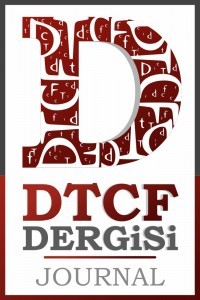BEBEK BEDENLERİN NESNELEŞTİRİLMESİ: İÇ SAVAŞ ÖNCESİ AMERİKA BİYOPOLİTİĞİNİ BEBEK GÖSTERİLERİYLE ANLAMAK
Bu çalışmanın amacı, İç Savaş öncesi Amerika toplumunda bebek gösterilerinin ailede, çocuk yetiştirmede, anne ve bebek bedenlerinin nesneleştirilmesinde ikili cinsiyet mantığının nasıl teşvik edildiğini İç Savaş öncesi Amerikan biyopolitiğiyle ilişkilendirerek araştırmaktır. Bu çalışma ilk olarak 1854 yılında tarım fuarlarının parçası olarak düzenlenen ilk bebek gösterilerinin biyopolitik yönlerini, bu olayların gazetelerdeki yansımalarına odaklanarak inceleyecektir. Daha sonrasında Phineas Taylor Barnum’un bebek gösterilerini ticari başarı için ucube gösterilerinin içine katarak 1855 yılında yeniden halka sunmasına değinilecektir. Bu çalışma Barnum’un gösterilerinde; beyaz Amerikan bebeklerinin üretilmesinin şovlarda düzenlenen anketlerde ve doktorların anne ve bebekleri değerlendirmedeki incelemelerinde nasıl teşvik edildiğini ve bu kıstasların en iyi Amerikan bebeğinin niteliklerini belirlemede öjenik bir normallik aşıladığını savunacaktır. Son olarak, anormal “ucubeler” ve “tuhaflıklar”ın “melek” bebeklerle yan yana getirilmesinin Barnum'un Amerikan müzesi aracılığıyla gerçekleştirilmesi, bu çalışmanın savunduğu üzere, Barnum müzesinin, kurallara uygun orta sınıf Amerikan aile yapısı yaratmak amacıyla bir Amerikan aile miti kurup söylemsel bir tarihsel gerçeklik oluşturmaya ve bunu teşvik etmeye çalışması ve bunu Amerikan ailesi üzerinde heterotopik bir otorite olarak güç/bilgi yetkisini kullanarak yapmasıyla açıklanacaktır.
Anahtar Kelimeler:
P.T. Barnum, İç Savaş Öncesi Amerika, Bebek Gösterileri, Michel Foucault, Biyopolitika
OBJECTIFICATION OF INFANTILE BODIES: UNDERSTANDING THE BIOPOLITICS OF ANTEBELLUM AMERICA THROUGH BABY SHOWS
The purpose of this study is to examine the function of baby shows in antebellum America in instigating binary logic of gender in family, child rearing, objectification of both infantile and maternal bodies; all of which are closely tied to the biopolitics of the antebellum America. This study will first look at the biopolitical aspects of the first baby shows organized as part of agricultural fairs in 1854 by focusing on the coverage of such events by newspaper articles. Then it will follow Phineas Taylor Barnum’s re-introduction of baby shows along with his freak shows in 1855 for commercial success. In Barnum’s shows, this study finds, the reproduction of properly bred white American babies is promoted through questionnaires and examinations of doctors in the evaluation of babies as well as the mothers to instill a eugenic normalcy with regards to determining the qualities of the best American baby. Lastly, the juxtaposition of the abnormal “freaks” and “oddities” with “cherubic” babies is realized through Barnum’s American museum which, as this study will argue, serves as a heterotopia in the sense that Barnum’s museum attempts to establish and thereby instigate a discursive historical truth of the proper middle-class American family in the form of a myth by exercising the power/knowledge over the American family as a heterotopian authority.
Keywords:
P.T. Barnum, Antebellum America, Baby Shows, Michel Foucault, Biopolitics,
___
- Baby Show Again. (1855). Retrieved January, 12, 2021, from https://lostmuseum.cuny.edu/archive/the-baby-show-again-new-york-herald-june-10.
- Baby-Show and Baby-Lecture. (1855). The Lost Museum Archive, Retrieved January, 12, 2021, from https://lostmuseum.cuny.edu/archive/the-babyshow-and-babylecture-new-york-tribune .
- Baby Show in Georgia. (1854). Washington Sentinel. p.3. Retrieved January, 12, 2021, from www.loc.gov/item/sn84020104/1854-12-16/ed-1/.
- Commercial Intelligence. (1854). Daily American Organ. p.2. Retrieved January, 12, 2021, from www.loc.gov/item/sn85042002/1854-11-24/ed-1/.
- Grand Infantile Display. (1855). Retrieved January, 12, 2021, from https://lostmuseum.cuny.edu/archive/the-baby-show-grand-infantile-display-new.
- Letters from McAron. (1862). Vanity Fair. pp. 267, Retrieved January, 12, 2021, from https://quod.lib.umich.edu/m/moajrnl/acg4267.0005.000/269:447?rgn=full+text;view=image;q1=approaching.
- Letters. (1855). Retrieved January, 12, 2021, from https://lostmuseum.cuny.edu/archive/letters-about-the-baby-shows-to-the-new-york.
- National Baby Show. (1854). The Independent Press. p.3. Retrieved January, 12, 2021, from www.loc.gov/item/sn93067882/1854-10-13/ed-1/.
- Spoons, O.G. Our Baby. Washington Sentinel. Retrieved January 12, 2021, from www.loc.gov/item/sn84020104/1854-11-11/ed-1/.
- The Baby Convention. (1854). Weekly National Intelligencer. p.6. Retrieved January, 12, 2021, from www.loc.gov/item/sn83045784/1854-10-14/ed-1/.
- The Baby Show. (1854). Weekly National Intelligencer. p.6. Retrieved January, 12, 2021, from www.loc.gov/item/sn83045784/1854-10-14/ed-1/.
- Adams, B. (1997). E Pluribus Barnum: The Great Showman And The Making Of U.S. Popular Culture. Minneapolis, Minn: University of Minnesota Press.
- Barnum, P. T. (2017). Barnum's Own Story. New York, NY: Dover Publications.
- Barnum, P. T., & Saxon, A. H. (1983). Selected letters of P.T. Barnum. New York: Columbia University Press.
- Benton, J. (1891) Life of Hon. Phineas T. Barnum. Philadelphia: Edgewood Publishing.
- Blanchard, P. (2008). Human Zoos: Science And Spectacle In The Age Of Colonial Empires. Liverpool: Liverpool University Press.
- Dr. C.H. Needham’s Breast Pump (n.d.). United States Patent and Trademark Office. Retrieved from https://patents.google.com/patent/US11135 .
- DuBois, E. C., & Dumenil, L. (2009). Through women's eyes: An American history with documents. Boston: Bedford/St. Martin's.
- Foucault, M. (1978). The History Of Sexuality Volume I. New York: Pantheon Books.
- Foucault, M., & Miskowiec, J. (1986). Of Other Spaces. Diacritics, 16(1), 22-27. doi:10.2307/464648.
- Haines, M., Craig, L., Weiss, T., & Cambridge, MA. National Bureau of Economic Research. (October 01, 2000). "Development, Health,
- Nutrition, and Mortality: The Case of the 'Antebellum Puzzle' in the United States".
- Hale, J.S., Godey L.A. (1856) Godey's Lady's Book and Magazine, 50-51, 571.
- Golden, J. L. (1996). A Social History Of Wet Nursing In America: From Breast To Bottle. Cambridge: Cambridge University Press.
- Morris, L. R. (1996). Incredible New York: High life and low life from 1850 to 1950. Syracuse: Syracuse University Press.
- Pearson, S.J. (2008). "Infantile Specimens": Showing Babies in Nineteenth-Century America. Journal of Social History 42(2), 341-370. doi:10.1353/jsh.0.0100.
- Welter, B. (1966). The Cult of True Womanhood: 1820-1860. American Quarterly, 18(2), 151-174. doi:10.2307/2711179.
- Wilson, R. (2020) Barnum: An American Life. New York: Simon & Schuster.
- Yayın Aralığı: Yılda 2 Sayı
- Başlangıç: 1942
- Yayıncı: Ankara Üniversitesi
Sayıdaki Diğer Makaleler
ŞİİRİN ÜÇ GÜZELİ: HÜSN-İ MATLAʻ, HÜSN-İ TAHALLÜS, HÜSN-İ MAKTAʻ
HOLLANDA HALK MASALLARI: YEREL-KÜRESEL GEÇİŞKENLİĞİ
TÜRKÇE BOYUT SIFATLARININ ANLAMSAL GÖRÜNÜMLERI: “BÜYÜK” VE “KÜÇÜK”
STRATEJİK İLETİŞİM ARACI OLARAK MÜZELERDE INSTAGRAM KULLANIM ANALİZİ: TROYA MÜZESİ ÖRNEĞİ
PUGAÇOV İSYANI’ NIN TEMATİK İZDÜŞÜMÜ: YÜZBAŞININ KIZI
BİR İNANÇ ESTETİZMİ ‘’HİNDUİZM’’: POLİTİK ESTETİZASYON VE PSİKOLOJİ
PATOČKA VE DELEUZE FELSEFESİNDE ASUBJEKTİF VE KİŞİSEL OLMAYAN
SAMİM KOCAGÖZ'ÜN ONBİNLERİN DÖNÜŞÜ ROMANINDA SOSYALİST ENTELEKTÜEL MESELESİ
